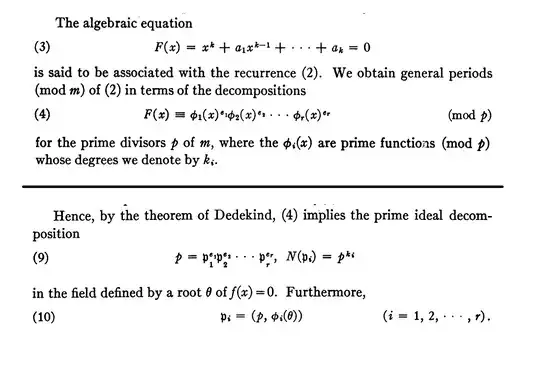This is a theorem from algebraic number theory. It is about how the prime ideal $(p)$ splits in the extension field $F=\Bbb{Q}(\theta)$.
The letter $N$ stands for norm (in the sense of ideals). $N(\mathfrak{p}_i)$ is the index of the prime ideal $\mathfrak{p}_i$ in the ring of integers $\mathcal{O}_F$ of the field $F$. It is a power of $p$, because the quotient ring $\mathcal{O}_F/\mathfrak{p_i}$ is a finite field of characteristic $p$.
For example if $F(x)=x^3-2$ we get $F=\Bbb{Q}(\root3\of2)$. It is not too difficult to see that in this case $\mathcal{O}_F=\Bbb{Z}[\root3\of2]$, but not too easy either, so I skip that part.
If we study the splitting of the prime $p=5$ we look at the factorization of $F(x)$ modulo $5$.
We easily find that
$$
x^3-2\equiv(x-3)(x^2-2x-1) \pmod5,
$$
but here the factor $x^2-2x-1$ has no zeros modulo five, so it is irreducible. Anyway the result states that the ideal $(5)=5\mathcal{O}_F$ factors as
$$
(5)=(5,\root3\of2-3)(5,\root3\of4-2\root3\of2-1).
$$
You see that the other generator of those ideals was gotten by plugging in $\root3\of2$ in place of $x$ in the modulo $5$ factorization of $F(x)$.
The result is due to Dedekind. It does not hold always, but it can be shown to hold in two important cases: 1) There are no repeated factors, i.e. $e_i=1$ for all $i$. 2) The powers of $\theta$ form a basis of $\mathcal{O}_F$ as a free abelian group.
The integers $k_i$ (aka inertia degrees) measure the size of the quotient rings - the ring $\mathcal{O}_F/(p,\phi_i(\theta))$ has $p^{k_i}$ elements.
They are also the degrees of the factors $\phi_i(x)$. So in the above example
$\Bbb{Z}[\root3\of2]/(5,\root3\of2-3)$ is a field of $5^1$ elements and
$\Bbb{Z}[\root3\of2]/(5,\root3\of4-2\root3\of2-1)$ is a field of $5^2$ elements reflecting the facts that the mod $5$ factors $x-3$ and $x^2-2x-1$
have degree $1$ and $2$ respectively.
Not sure if this helps. I should not attempt to reproduce scores of pages from an introduction to the theory of algebraic numbers :-/
